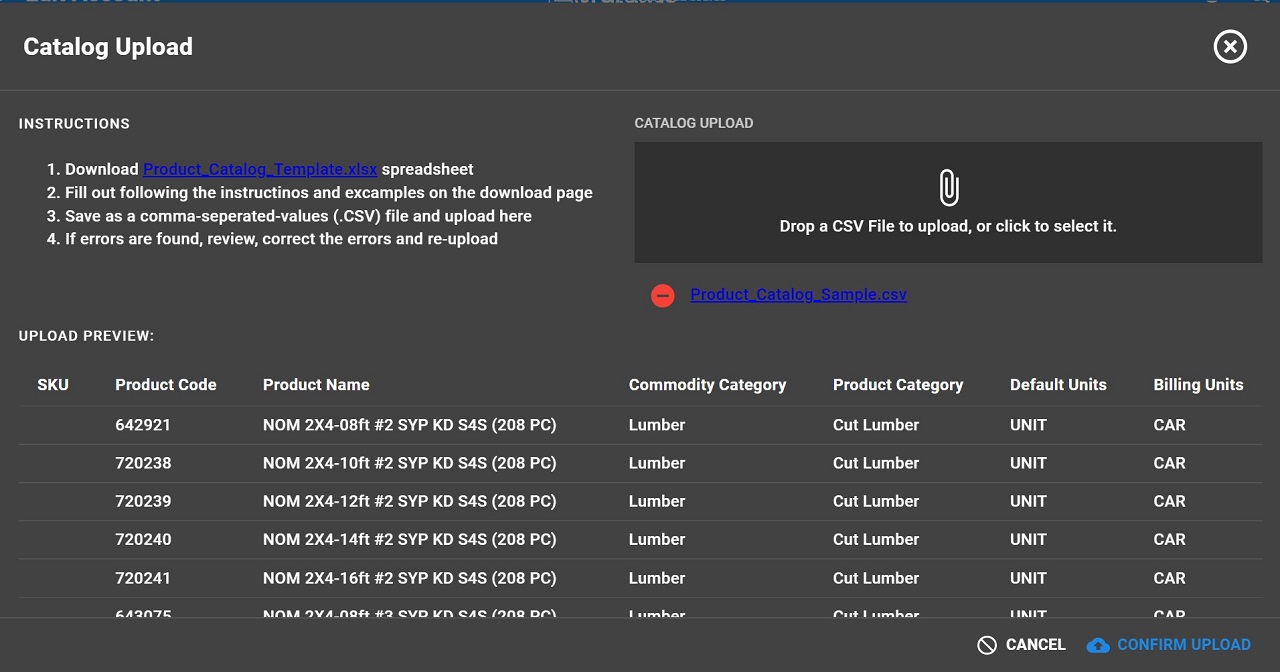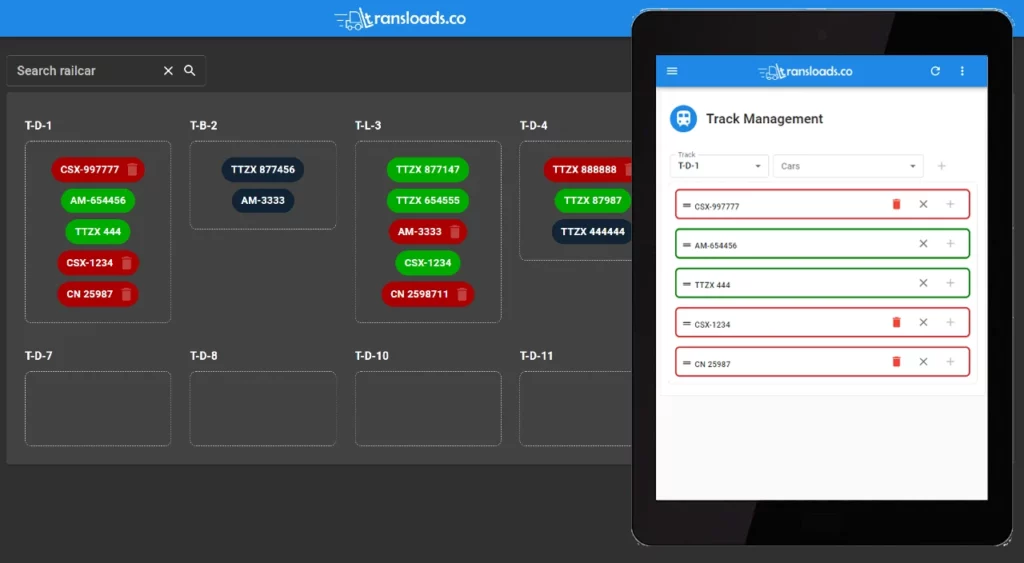product catalog bulk upload

A Product Catalog allows the operator to quickly configure an Inbound Shipment by searching through pre-configured list of products, rather than entering data manually. Additional benefits extend to more detailed reporting capabilities and automatic units of measurement conversions. We strongly encourage adding products manually or bulk uploading through the following process.
STEPS:
Please follow these instructions below to fill-out and upload a product catalog. The upload file must be in a comma-separated-values (CSV) format. The template file can be edited using Excel, Google Sheets, or Apple Numbers.
Our customer success experts are available to assist you. Just email us at support@transloads.co
STEP 1: Download Template Spreadsheet
Download the product catalog template and save as an Excel (.XLSX) file. Open to edit.
STEP 2: Review Column Definitions
Become familiar with the meaning of each column. Do not rename or delete column header names or change their order. Such changes will cause file parsing errors. However, you can insert new columns anywhere to add custom, user-defined product properties.
- Product Code: a unique, manufacturer-provided SKU, Product Code, or UPC registered with GS1 US. Once product is created or uploaded, a product code cannot be modified.
- Required, case-sensitive
- Valid Entries: free-form alpha-numeric. Each product code must be unique within one account’s product catalog.
- Name: Product name, should include piece count (PC) if used for bundled goods.
- Required, case-sensitive
- Valid Entries: free-form alpha-numeric.
- Example: 2x4x08 SPF 2&BTR 208 PC
- Commodity Category: commodity category corresponding to commodities listed within “My Yard > Commodities” setup tab.
- Required, case-sensitive
- Valid Entries: Lumber, Engineered Lumber, Steel, Cable Spool, Panels, Palletized Commodities, Building Products, Dry Bulk, Liquid Bulk, Other
- Product Category: custom product categorization for reporting by product category.
- Optional, case-sensitive
- Valid Entries: free-form alpha-numeric.
- Examples: Lumber, Cut Lumber, Plywood, OSB, etc.
- Default Units: units of measure used for counting/measuring quantity of product in shipment and in inventory. Same units of measure will be used for Inbound Shipment, Inventory management, and Outbound Shipments. Once default units are selected, find a corresponding “Conversion Unit” below and enter “1” as base count to be used for all other unit-to-unit conversions.
- Required, case-sensitive
- Valid Entries: UNIT, PIECE, CWT, LF, SF, MBF, TON, LBS, GAL
- Billing Units: select units of measure for billing / invoicing purposes.
- Required, case-sensitive
- Valid Entries: UNIT, PIECE, CAR, TL, CWT, LF, SF, MBF, TON, LBS, GAL
- UNIT: a unit, bundle or a box – consists of many pieces (PC)
- Required if “UNIT” is selected as “Default Units” or “Billing Units”, otherwise Optional and can be left blank
- Valid Entries: numeric, set to 1 if selected as “Default Units”
- PIECE: pieces – individual items in a UNIT
- Required if “PIECE” is selected as “Default Units” or “Billing Units”, otherwise Optional and can be left blank
- Valid Entries: numeric, set to 1 if selected as “Default Units”
- MBF: thousand board feet – used for lumber measurements
- Required if “MBF” is selected as “Default Units” or “Billing Units”, otherwise Optional and can be left blank
- Valid Entries: numeric, set to 1 if selected as “Default Units”
- LF: linear feet – used primarily for engineered lumber measurements
- Required if “LF” is selected as “Default Units” or “Billing Units”, otherwise Optional and can be left blank
- Valid Entries: numeric, set to 1 if selected as “Default Units”
- SF: square feet – used primarily for measurements of panels
- Required if “SF” is selected as “Default Units” or “Billing Units”, otherwise Optional and can be left blank
- Valid Entries: numeric, set to 1 if selected as “Default Units”
- GAL: Gallons
- Required if “GAL” is selected as “Default Units” or “Billing Units”, otherwise Optional and can be left blank
- Valid Entries: numeric, set to 1 if selected as “Default Units”
- LBS: pounds
- Required if “LBS” is selected as “Default Units” or “Billing Units”, otherwise Optional and can be left blank
- Valid Entries: numeric, set to 1 if selected as “Default Units”
- CWT: hundredweight = 100 LBS
- Required if “CWT” is selected as “Default Units” or “Billing Units”, otherwise Optional and can be left blank
- Valid Entries: numeric, set to 1 if selected as “Default Units”
- TON: 1000 Kg or 2000 LBS
- Required if “TON” is selected as “Default Units” or “Billing Units”, otherwise Optional and can be left blank
- Valid Entries: numeric, set to 1 if selected as “Default Units”
- Low Inventory Alert: set low inventory quantity to generate alerts in low inventory reports.
- Optional
- Valid Entries: numeric entries greater than or equal to 0, or blank. Blank = 0.
- Width: product width in default units of measure (inches, feet, cm, meters). If packaged, measure Unit/Bundle/Box size.
- Optional
- Valid Entries: numeric entries greater than 0, or blank.
- Length: product length in default units of measure (inches, feet, cm, meters). If packaged, measure Unit/Bundle/Box size.
- Optional
- Valid Entries: numeric entries greater than 0, or blank.
- Height: product height in default units of measure (inches, feet, cm, meters). If packaged, measure Unit/Bundle/Box size.
- Optional
- Valid Entries: numeric entries greater than 0, or blank.
- “Custom Column”: any custom property required to describe the product or commodity. Omit the quotes.
- Optional
- Valid Entries: free-form alpha-numeric, or blank.
- Examples: Heat Number, Tag Number, Color, etc.
STEP 3: Review Examples
Please study the following examples to help you complete the spreadsheet correctly.
The following example show how to populate the spreadsheet for a sample Lumber upload. Please note
- each row / product has a unique “Product Code”
- “Product Name” includes number of Pieces in a Unit / Bundle
- By selecting “UNIT” as the “Default Units” of measure, the corresponding “UNIT” column has been populated with “1” as base figure. Highlighted in Yellow.
- The “PC” column represents number of Pieces per Unit, as in 1 UNIT = 128 PC
- By selecting “MBF” as the “Billing Units”, the corresponding “MBF” column has been populated with a calculated number of MBFs per 1 UNIT, as in 1 UNIT = 1.02 MBF. Highlighted in Green.
- Additional relevant conversion units have been populated, as in 1 UNIT = 1505 LBS

STEP 4: Initial Upload
Initial upload can be performed during Account creation process, or after an Account has been already created. Navigate to the “Product Catalog” tab and either click the drop zone or drag an drop a completed spreadsheet onto the drop zone.
Once the file is uploaded it will be checked for correctness. If any errors are found, they will be displaced below the uploaded file, including a sampling of rows containing errors. Please review the error messages, make appropriate corrections and re-upload the file again. Once all rows are parsed successfully without errors, a sampling of the rows will be displayed for your final review.
STEP 5: Re-upload / Bulk Update
You may always add new products to the catalog, or perform bulk update by uploading a new CSV file. If the new file contains products with pre-existing Product Codes, those product records will be over-written with the new values and thus updated.

